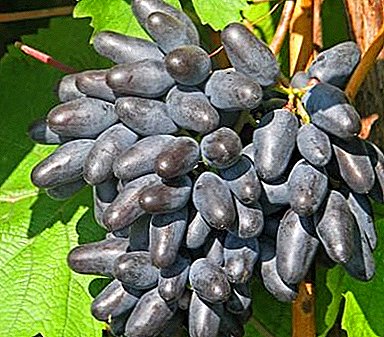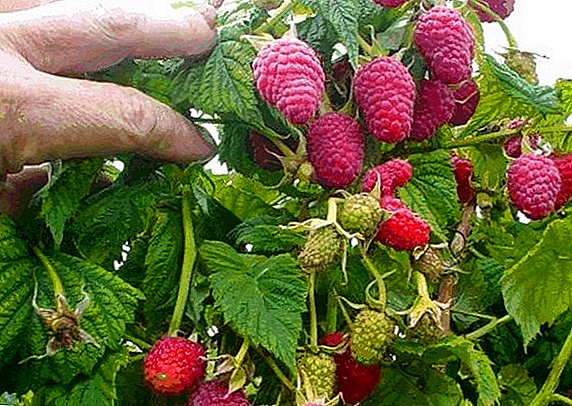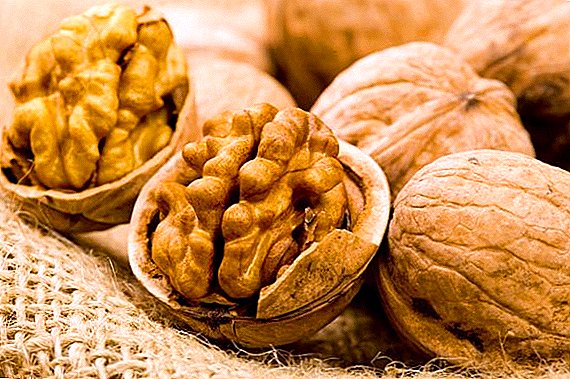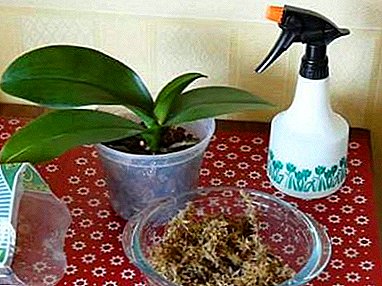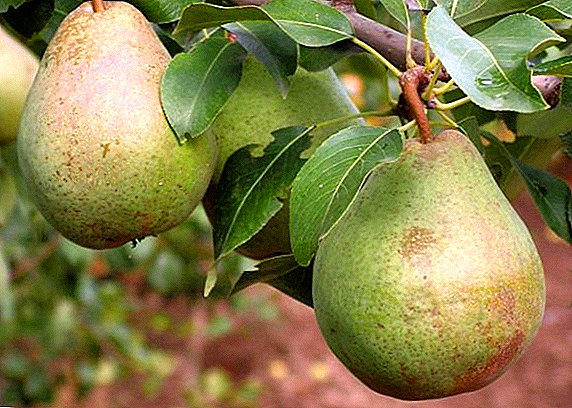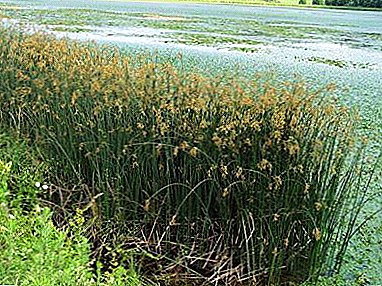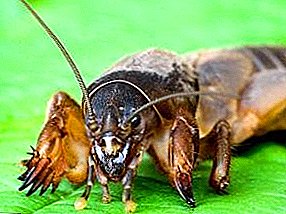 Medvedka - a large insect from the order Orthoptera.
Medvedka - a large insect from the order Orthoptera.
They called it so because of the awkward body, which is densely covered with dark brown hairs.
Young larvae have a gray color and are very voracious, for which they are called "tops."
Probably for a special addiction to cabbage, this insect in the people is also called "cabbage." Due to the unusual structure of the front paws - claws with a toothed saw - the medvedka is called the "earthen cancer". And from Latin, her name translates as "cricket-mole".
Appearance of a bear
Representatives of the family grow up to 5-8 cm. The abdomen is 3 times more than the cephalothorax, it reaches 3-3.5 cm. It is soft and has the shape of a spindle, at the end are paired antennae, appendages about 1 cm long. They are called cerci.
 Unlike other crickets, the bear has no ovipositor. The thoracic shell protecting the head of the chest is firm and strong. In case of danger the insect can partially hide its head under it.
Unlike other crickets, the bear has no ovipositor. The thoracic shell protecting the head of the chest is firm and strong. In case of danger the insect can partially hide its head under it.
The long wings of adult individuals hide under scales in the form of scales, often longer than the abdomen. On the triangular head of the bear there are two faceted eyes, as well as long whiskers and two pairs of tentacles on the sides of the mouth with strong horn jaws. On back legs 4-5 thorns are located. The front legs of a bear are different.
They are very powerful, short, with a thickened lower leg and, as if turned outside, similar to the paws of a mole. It is an ideal device for digging underground labyrinths in which the bears live.
Phylloxera is a dangerous pest of grapes.
Find out the best table grapes by clicking on the link.
Description of grape varieties: //rusfermer.net/sad/vinogradnik/sorta-vinograda/luchshie-sorta-vinograda.html
Types and distribution area
The genus of the bear has 5 species and belongs to the family of crickets. The interspecies differences of the bear are insignificant. Basically it is the habitat and size.
Types of Bears:
1. The common bear (Gryllotalpagryllotalpa) - the species is distributed throughout Europe, except France, Norway and Finland, to Western Asia, as well as in Kazakhstan, North Africa and the South Caucasus. This type of bear is a cosmopolitan, it has the largest distribution area.
2. African bear (Gryllotalpaafricana) - has a slightly smaller size - only 2-4 cm. It is distributed throughout Asia, Japan, China, India, as well as in Australia and the Philippine Islands. There is an African bear in Russia.
3. The Far Eastern Medvedka (Gryllotalpafossor) lives in Japan, Central and South Asia, China, Kazakhstan, Kyrgyzstan, and Uzbekistan. In Russia, on Sakhalin, in the Urals, Ussuri and Primorsky Territories.
4. The ten-winged bear (Neocurtillahexadactyla) is the smallest of the bears, the length of its body is only 1.5-3 cm, herbivorous. Distributed in the east of North America, in Mexico, Panama. It was imported and successfully settled down in South America (Brazil, Colombia, Ecuador).
5. A single-headed bear (Gryllotalpaunispina) - also called a slim or Turkestan bear, classified by the famous Swiss entomologist Henri de Saussure.
Lifestyle and habitat
Medvedka loves sandy soils lit by the sun in flat terrain. Avoids dry places and settles near water bodies in moist soil. Medvedki is a serious fruit pest. They love to make their nests in gardens.
Building tunnels, they gnaw through the roots and tubers of plants, spoil the bulbs and roots. To move the insects use three elements at once - earth, air and water. During the day they lay underground corridors, and at night they can fly at a height of 50 cm to 5 m over long distances.
The mink of the Medvedka is a small camera that expands to the exit and has many moves, going underground from 5 to 20 cm in the summer, and up to 1-2 m in the winter. Bears are not in vain belong to the family cricket. Their chirping can be heard not only at night, but even during the day.
The sound power of the bear is twice the sound power of the cricket. And thanks to a hole in the shape of a horn, acting as a resonator, it can be heard at a distance of 600 m from the source. Chattering - the way of communication of the bear. There are almost a thousand types of trills that carry a variety of information.
Peach: care and cultivation. Read on our site all about growing peaches on our site.
Features of cherry planting: //rusfermer.net/sad/plodoviy/posadka-sada/poleznye-svojstva-vishni-a-takzhe-posadka-i-uhod-za-kulturoj.html
Breeding bear
With the onset of heat, in March-April, and in some areas until the end of June, the mating season begins at the honeymoon. At this time, their trills are especially well heard.
 After mating, the female builds a spherical nest near the main course at a depth of 10-20 cm, which also has several turns. To protect the eggs, the female exudes a special mucus that covers the walls of the nest.
After mating, the female builds a spherical nest near the main course at a depth of 10-20 cm, which also has several turns. To protect the eggs, the female exudes a special mucus that covers the walls of the nest.
The laying is from 200 to 600 yellowish eggs about 2.5 mm in size. Pale yellow larvae appear in a fortnight.
At first, they are blind and feed on the yolk sac in the goiter. They become gray after the first molt, crawl out of the nest, begin to feed on humus and young roots, and, growing up, pass to the tubers and rhizomes of plants, earthworms and larvae of other insects. In the adult individual larvae develop slowly, from 1.5 to 2.5 years.
Harm from the bear
Medvedka is a serious fruit pest. Laying their moves, insects gnaw everything in their path. They tear up the roots and spoil the stems of all garden crops. Medvedka eats seeds, gnaws root vegetables.
 Due to the underground way of life of the pests, birds do not affect the number of their populations, and adult insects are quite prolific. During the season, the female lays from 200 to 600 eggs.
Due to the underground way of life of the pests, birds do not affect the number of their populations, and adult insects are quite prolific. During the season, the female lays from 200 to 600 eggs.
In search of favorable living conditions, the bears can travel long distances.
They love to settle in gardens and areas with wet, well-fed, loose earth, with a high content of humus.
Methods of dealing with Medvedka
About the presence of a bear on a plot or in the garden, you will be prompted by small mounds of rolled up lumps of soil. In these places, the plants wither and die.
It is possible to bring out a Medvedka, but for this you should choose an integrated approach and carry out measures to combat this pest in three directions throughout the year. Firstly, to protect plants from insects, secondly, to apply mechanical methods to catch insects and destroy their eggs, and, thirdly, to protect their area from the penetration of new individuals.
The use of chemical insecticides is recommended only as a last resort. With proper persistence with a medvedka, you can cope without them, without poisoning the earth with carcinogens.
To Medvedka not come to you from another site, you should protect your territory around the perimeter. You can make a fence of sheets of tin or slate 30-50 cm in height, buried in the ground 50-60 cm deep. Instead of a fence, you can dig a groove along the perimeter to the same depth and fill it with sand or sand dipped in kerosene (one tablespoon of kerosene per sand bucket).
In early spring and autumn, the ground should be deeply plowed, and deep loosening of the soil should be carried out throughout the season. In this way, underground tunnels, nests with eggs and roving larvae are destroyed.
In the spring for the bear make an egg shell bait, ground on a coffee grinder and moistened with sunflower oil. It is important to use the bait in early spring, before the appearance of the first sprouts, since later the bear will prefer her tender plants. This mixture can be laid in the wells and grooves directly from the seed during planting. Medvedka, eating such bait, dies.
 Also in spring, during the mating season of the Bears, you can prepare shallow pits and fill them with manure. Or just spread out on the site of a small dung heap.
Also in spring, during the mating season of the Bears, you can prepare shallow pits and fill them with manure. Or just spread out on the site of a small dung heap.
Bears crawl into the manure and lay eggs there. In about a month, the manure is burned with the larvae.
In the summer, when weeding and loosening the earth, you can detect holes in the moves of a bear. They need to be poured with soapy water (10g of household soap, 50g of laundry detergent per bucket of water) or a mixture of water with kerosene (100g per 10l of water) in a volume of 0.5l per turn. After some time, Medvedka dies underground or goes to the surface, where it is necessary to collect and destroy it.
Traps for the bear
The use of various traps gives good results. Such traps can be easily made by yourself. Usually for traps use glass half-liter jars, which are buried in the neck in the ground.
Banks are filled with water, leaving 4-8 cm to the edge, so that Medvedka that got there could not get out. As a bait, you can coat the neck of the jar on the inside with honey, or you can put chopped potato tubers into it.
Instead of water, you can pour a little beer into a can, its smell will be lured by a bear. It is important to regularly check the traps and destroy the insects crawling in them.
In autumn, until the soil temperature drops below +8 degrees, you should dig two holes for every 100 square meters, 50-60 cm deep, cover them with plastic wrap and cover them with fresh horse or cow manure, sprinkle them on top. Medvedka climbs in the prevailing warm manure for the winter.
It is important to have time to prepare such traps before the temperature of the soil drops to +5 degrees, because with the onset of cold weather the polar bears become inactive and go deeper into the ground. After the onset of stable frosts, manure, along with insects, is scattered on the ground, and the bears die from cold.
In order to better preserve the crop, along with catching and destroying the bears, measures should be taken to protect the plants. When planting seedlings of peppers, tomatoes, eggplants use various barriers around the stem of the plant.
For example, pieces of rubber hoses, plastic bottles, tin cans of canned food, nylon mesh. It is important that the fence protrudes 2-3 cm above the soil surface.
Before you plant a blackberry on your site, find out its varieties. Blackberry varieties.
Specifics of care for gooseberries: //rusfermer.net/sad/yagodnyj-sad/posadka-yagod/kryzhovnik-kak-pravilno-vysazhivat-uhazhivat-i-lechit.html
Folk means of dealing with Medvedka
Struggling with Medvedka for many years, watching her habits and habits, gardeners have gathered a large arsenal of simple tools that scare away the pest and can help protect the crop. Do not neglect them, because over the long history of use, they have proven to be effective.
 In habitats of bears it is impossible to fertilize plants with cow or horse manure. And chicken droppings, on the contrary, scare away these insects.
In habitats of bears it is impossible to fertilize plants with cow or horse manure. And chicken droppings, on the contrary, scare away these insects.
It should be watered with diluted bird droppings in dry weather. This infusion can be poured into the moves.
Pine needles will help protect the potato from the bear if you throw it in a handful at the hole. A half-glass of wood ash added to the same, will save the potatoes from the bear, wireworm and even scab. Also, when planting plants, dry crushed stalks of chrysanthemums, a clove of garlic, onion peel are put in the hole.
Medvedka does not like the smell of rotten fish. You can bury raw fish 15-20 cm deep into the garden, it will quickly begin to rot and its smell will scare away the pest.
When sowing root seeds Medvedka can scare off the smell of iodine. It is necessary to add 15 drops of iodine to a bucket of water in the water for irrigation of crops.
Medvedka is also afraid of the smell of marigolds, coriander, calendula and parsley. These plants are better to plant around the perimeter of the site. Both aspen and alder pegs, placed on the border every 1.5-2 m, will help.
As you can see, there are a lot of methods to fight with Medvedka. All of them are effective, but the most important thing is to act in a comprehensive and consistent manner. Then the effort will bring success, and this pest will leave your site forever.
We make a barn with our own hands in the country. Description of the process on our website.
Making bird feeders: //rusfermer.net/postrojki/sadovye-postrojki/dekorativnye-sooruzheniya/kormushki-dlya-ptits-svoimi-rukami-iz-podruchnyh-materialov.html


 Phylloxera is a dangerous pest of grapes.
Phylloxera is a dangerous pest of grapes. Peach: care and cultivation. Read on our site all about growing peaches on our site.
Peach: care and cultivation. Read on our site all about growing peaches on our site. Before you plant a blackberry on your site, find out its varieties. Blackberry varieties.
Before you plant a blackberry on your site, find out its varieties. Blackberry varieties. We make a barn with our own hands in the country. Description of the process on our website.
We make a barn with our own hands in the country. Description of the process on our website.